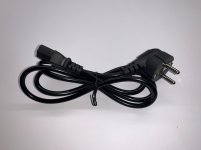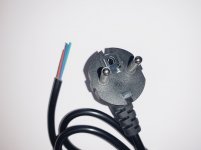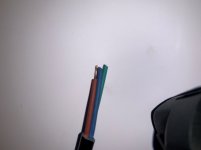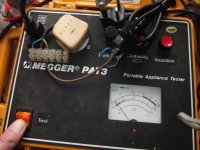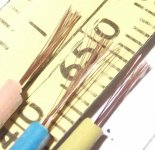I performed a web search on the topic of this thread but found no information that applied, and knowing not only the generous spirit of the members on this forum but also the fact that many are experienced in various technological professions and are all around "sciencey" kind of guys, I humbly post it here in the hope that someone can shed some light on a most perplexing mystery.
I own a small two-wheeled truck of tubular steel construction with a small open steel platform at its base which rests and rolls upon two pneumatic rubber tires. It is the kind of cart normally used for transporting heavy objects such as large boxes, furniture, and appliances over short distances. In my area it is commonly called a "two wheeler". As the spring season wore on and the weather warmed the lawn grass began to grow again and I began my springtime outdoor chores. One of those tasks involved moving some items over the lawn with my two wheeler and a few days after doing so I noticed that there were yellow tracks in the green grass where the tires had passed over. I took notice but had little concern because as the grass grew the yellow portions of the grass blades grew upward with green portions of the same blades pushing up from underneath. The yellow portions of the blades were at the top where the tires had contacted them.
To the best of my knowledge the tires have never come into contact with any herbicide or other poisonous substance and the truck, which is about two years old, has never been used off of my property. I purchased it at one of the large home improvement stores here in the US. It was manufactured in this country, but the pneumatic tires, which appear to be made of a curious amalgam of normal rubber and perhaps vinyl, are embossed with a phrase that indicates their place of origin is a geographically large Asian country with a tremendous population and a large manufacturing base.
Could the tires present toxic contact to plants? I can think of no other explanation. I am not overly concerned as the effect on the grass was temporary and superficial, not systemic, and the green grass is now growing in the affected tracks and seems to be perfectly healthy. I myself have no intention of eating the tires but I will be sure to wash after handling them for purpose of inflation.
If anyone has heard of this effect from another source or could offer an educated guess as to the cause of the yellowing of the grass in the tire tracks which cleared to green as the grass grew, I would be interested to hear from you.
I own a small two-wheeled truck of tubular steel construction with a small open steel platform at its base which rests and rolls upon two pneumatic rubber tires. It is the kind of cart normally used for transporting heavy objects such as large boxes, furniture, and appliances over short distances. In my area it is commonly called a "two wheeler". As the spring season wore on and the weather warmed the lawn grass began to grow again and I began my springtime outdoor chores. One of those tasks involved moving some items over the lawn with my two wheeler and a few days after doing so I noticed that there were yellow tracks in the green grass where the tires had passed over. I took notice but had little concern because as the grass grew the yellow portions of the grass blades grew upward with green portions of the same blades pushing up from underneath. The yellow portions of the blades were at the top where the tires had contacted them.
To the best of my knowledge the tires have never come into contact with any herbicide or other poisonous substance and the truck, which is about two years old, has never been used off of my property. I purchased it at one of the large home improvement stores here in the US. It was manufactured in this country, but the pneumatic tires, which appear to be made of a curious amalgam of normal rubber and perhaps vinyl, are embossed with a phrase that indicates their place of origin is a geographically large Asian country with a tremendous population and a large manufacturing base.
Could the tires present toxic contact to plants? I can think of no other explanation. I am not overly concerned as the effect on the grass was temporary and superficial, not systemic, and the green grass is now growing in the affected tracks and seems to be perfectly healthy. I myself have no intention of eating the tires but I will be sure to wash after handling them for purpose of inflation.
If anyone has heard of this effect from another source or could offer an educated guess as to the cause of the yellowing of the grass in the tire tracks which cleared to green as the grass grew, I would be interested to hear from you.
If anyone has heard of this effect from another source or could offer an educated guess as to the cause of the yellowing of the grass in the tire tracks which cleared to green as the grass grew, I would be interested to hear from you.
Did you check for any brake or hydrolic fluid contamination? Before they switched to all electric maintenance vehicles this would happen at our muni golf course.
Ever notice the smell when you walk into a Harbor Freight store? My wife cant even go in the place... Ever notice how it's stronger when you walk toward the section where the replacement pneumatic (and other) tires are? Whatever they make these things out of, seriously outgasses something you can readily smell. Unsure if any connection...
Recently I attempted to solder wires belonging to an air-pump manufactured in unsaid country of origin. Stripped, they looked like normal copper wire. Soldering, you better be quick and nail it the first try. With a lot of heat the wire resembles copper plated plastic - whatever it is, it becomes unsolderable after heating. Forget tinning first - ruins the wire completely. I've NEVER seen anything like it - what type of conductive material just turns black after heating and refuses to wick up any solder - copper plated aluminum?
Who knows what material mixtures they come up with to make it a little cheaper to produce, yet provide adequate service in enough cases to sell?
Recently I attempted to solder wires belonging to an air-pump manufactured in unsaid country of origin. Stripped, they looked like normal copper wire. Soldering, you better be quick and nail it the first try. With a lot of heat the wire resembles copper plated plastic - whatever it is, it becomes unsolderable after heating. Forget tinning first - ruins the wire completely. I've NEVER seen anything like it - what type of conductive material just turns black after heating and refuses to wick up any solder - copper plated aluminum?
Who knows what material mixtures they come up with to make it a little cheaper to produce, yet provide adequate service in enough cases to sell?
Last edited:
Beetlejuice, im not sure what part of the country your in but some fresh spring grass is rather delicate to traffic. Especially if there is still frost in the mornings.
I purchased the truck new at the big box home improvement store and the tires were clean at that time. It has sat in my garage since then and the tires have not come into contact with any fluids other than rainwater in damp ground. I have walked extensively on the grass since it began to grow this season and my footsteps have not produced the same yellowing effect as the tires.
My assumption is that the chemical composition of the tires is at fault, and I find it remarkable that such transient contact as the tires rolling once over the grass in question could produce such an effect. I wonder if any ill effects could come from contact with human skin, and I hope that the people who assemble these trucks do not suffer any health problems as a result. The factory workers who manufacture the tires and who presumably not only contact them but also breathe the fumes produced by the manufacturing process have my sympathy. As a young man I once considered applying for a job at a small rubber tire factory, but as the interior gave me the impression of Hell on earth I fled as though the Devil were chasing me. In any case, I will wash thoroughly after handling the tires for any reason.
My assumption is that the chemical composition of the tires is at fault, and I find it remarkable that such transient contact as the tires rolling once over the grass in question could produce such an effect. I wonder if any ill effects could come from contact with human skin, and I hope that the people who assemble these trucks do not suffer any health problems as a result. The factory workers who manufacture the tires and who presumably not only contact them but also breathe the fumes produced by the manufacturing process have my sympathy. As a young man I once considered applying for a job at a small rubber tire factory, but as the interior gave me the impression of Hell on earth I fled as though the Devil were chasing me. In any case, I will wash thoroughly after handling the tires for any reason.
If the truck has hardly been used it may be the mold release agent used to stop the tire sticking when it is made.
It will most likely wash off with dish soap and hot water if you are worried about the marks on the grass the first few times you use it.
It is some kind of silicon oil I think.
It will most likely wash off with dish soap and hot water if you are worried about the marks on the grass the first few times you use it.
It is some kind of silicon oil I think.
Tyres have all sorts of additives to make the rubber go hard.
One is an acid which I cant remember offhand.
Rubber in its natural form is liquid.
One is an acid which I cant remember offhand.
Rubber in its natural form is liquid.
> moving some items over the lawn with my two wheeler
What "items"?
I routinely move stuff over 200 pounds on my handtruck. The tire contact patch is smaller than my #10 shoe. Take half of 200lbs on each tire, assumed 1.5" by 3" contact length; all my 192lbs on one shoe.
100lbs/4.5sqin = 22lbs/sqin = 3,200lbs/sqft
192lbs/48sqin = 4lbs/sqin = 600lbs/sqft
When planting a house, 1000lb/sqft is significant; if the soil supports that then light construction needs no special care. Heavy construction on small footings can exceed 300lbs/sqft and then you want very firm hard soil.
Class of Materials Load-Bearing (pounds per square foot)
Sedimentary rock 6,000
Sandy gravel or gravel 5,000
Sand, silty sand, clayey sand, silty gravel, and clayey gravel 3,000
Clay, sandy clay, silty clay, and clayey silt 2,000
My clay in spring: <1,000 (est)
And as the mountain man says: mature dry grass will take abuse but you know you do not walk on fresh-sprouted grass, and re-sprouting grass in thawing ground may also be sensitive.
Your numbers will differ. If your "items" were boxes of neck-ties (don't ask) then the load is 20lb and pressure is 320lb/sqft or half of a shoe.
--------------
"Natural" rubber has not been common since WWII (access to rubber was one of the friction points). What little was still used dried up with the troubles in Indochina. Natural latex is a specialty for the few uses which do not allow modern synthetics. Which are nothing to do with plants but just chemicals built from butes and styrenes. They may be supplied as liquid if needed but "chunks" are also common since it will be mixed with fillers in a Waring blender.
What "items"?
I routinely move stuff over 200 pounds on my handtruck. The tire contact patch is smaller than my #10 shoe. Take half of 200lbs on each tire, assumed 1.5" by 3" contact length; all my 192lbs on one shoe.
100lbs/4.5sqin = 22lbs/sqin = 3,200lbs/sqft
192lbs/48sqin = 4lbs/sqin = 600lbs/sqft
When planting a house, 1000lb/sqft is significant; if the soil supports that then light construction needs no special care. Heavy construction on small footings can exceed 300lbs/sqft and then you want very firm hard soil.
Class of Materials Load-Bearing (pounds per square foot)
Sedimentary rock 6,000
Sandy gravel or gravel 5,000
Sand, silty sand, clayey sand, silty gravel, and clayey gravel 3,000
Clay, sandy clay, silty clay, and clayey silt 2,000
My clay in spring: <1,000 (est)
And as the mountain man says: mature dry grass will take abuse but you know you do not walk on fresh-sprouted grass, and re-sprouting grass in thawing ground may also be sensitive.
Your numbers will differ. If your "items" were boxes of neck-ties (don't ask) then the load is 20lb and pressure is 320lb/sqft or half of a shoe.
--------------
"Natural" rubber has not been common since WWII (access to rubber was one of the friction points). What little was still used dried up with the troubles in Indochina. Natural latex is a specialty for the few uses which do not allow modern synthetics. Which are nothing to do with plants but just chemicals built from butes and styrenes. They may be supplied as liquid if needed but "chunks" are also common since it will be mixed with fillers in a Waring blender.
Last edited:
Thanks for the detailed reply. The items in question were empty plastic trash and recyclables containers that I roll to the curb for waste company truck pickup. My driveway and lawn are situated in such a way that the normal "to the curb" route of the driveway is longer than the direct route over the grass. I always use the long route with full containers, but will occasionally use the shortcut on the return. In this particular case I used the short route over the grass only once and saw the effect a few days later. I am confident that my footsteps put more squash on the grass than the two wheeler, plus this is the very first time I noticed the effect in years of the same routine. The only variable, I believe, is the hand truck.
Recently I attempted to solder wires belonging to an air-pump manufactured in unsaid country of origin. Stripped, they looked like normal copper wire. Soldering, you better be quick and nail it the first try. With a lot of heat the wire resembles copper plated plastic - whatever it is, it becomes unsolderable after heating. Forget tinning first - ruins the wire completely. I've NEVER seen anything like it - what type of conductive material just turns black after heating and refuses to wick up any solder - copper plated aluminum?
This is the famous "aluminium bronze" or "anymetalmix" made in unsaid country of origin. When you twist the wires they will turn back 🙂 These are not solderable, you can only crimp the cables. Do not attempt to solder these cables as they WILL come loose and may cause unsafe situations. Probably soldering fumes are toxic.
Even worse I recently had a lot seemingly identical RCA connectors of which a few were 100% ferro (ALL parts). Kind of gold plated in a way, possibly gold paint 😉 Some were made of a strange mix containing copper, zinc, tin etc. Brittle but it was usable. Nevertheless I finished them all with The Terminator pliers.
I curse those that produce this kind of terrible bad quality stuff. A waste of materials and bad for the environment.
Last edited:
Slightly off topic,
In construction, years ago, our nails came from Chile and were just fine. Then the supply started coming in from China. If you didn't massage and hit each nail perfectly, they would bend. I only surmised that China was selling nails that were made of their waste metals and who knows what else. I started washing my hands each day for just that.
S
In construction, years ago, our nails came from Chile and were just fine. Then the supply started coming in from China. If you didn't massage and hit each nail perfectly, they would bend. I only surmised that China was selling nails that were made of their waste metals and who knows what else. I started washing my hands each day for just that.
S
I started washing my hands each day for just that.
Revolution!
This is the famous "aluminium bronze" or "anymetalmix" made in unsaid country of origin. When you twist the wires they will turn back 🙂 These are not solderable, you can only crimp the cables. Do not attempt to solder these cables as they WILL come loose and may cause unsafe situations. Probably soldering fumes are toxic...
Thank-you - I thought I was losing my mind over this wire. I was considering crimping them to a wire type I could solder to, when working with it. I'll be wary of these soldered connections I was barely able to make; they do have a cover of glue assisting the mechanical stability.
Yes, very frustrating. I have seen it in IEC cords too even with A branded stuff. Since then I keep older quality IEC cords in honor.
Stupid thing is you will only know when you take them apart (and so you can't use them again). I discovered it when a new IEC cord melted suddenly. It was crimped erroneously.
Stupid thing is you will only know when you take them apart (and so you can't use them again). I discovered it when a new IEC cord melted suddenly. It was crimped erroneously.
Last edited:
Those fake IEC cords are dangerous. I attach a picture of the power cord that is currently supplied with a device sold by a "marketplace" seller on a popular ecommerce web site. Most people are unaware that they are not purchasing from a domestic supplier, even if they pay to a commercial entity that is (fictiously?) based in EU. In US market this works in the same way, I believe. The end user is the importer; the seller does not bear any risk when it sells a item that is not compliant with safety regulations. And this is exactly what some unscrupoulous business is doing. The visible part of the wire does have a standard IEC identification code, with good data: 3x0.75mmq, the manufacturing date, the manufacturer name (YAOYOUE in this specimen), the wire classification and the insulation material (PVC). The moulded plug does not have any manufacturer or safety mark, the only marking is the 16A 250V number; this is a red flag already. The cable looks flimsy and does not feel like a regular 3x0.75 PVC, but this is not obvious to untrained people. Cutting the cable reveals that the external jacket is very thin, and the bulk of the insulation is some unspecified rubber-like plastic. Conductors color is wrong, the section is much smaller than 0.75mmq, and they are made of alluminium. If you use this cord for a bigger load, let's say a laser printer, it will overheat and melt without tripping the circuit breaker until the wires finally short out. This is a real fire and electrical hazard, because the naked conductor will poke trough the melted insulation. And the crimping inside the plug may go bad easily. I've found several cords of this type already; this is becoming a real issue. IEC power cords are quicky interchanged with other devices. As example, people may be tempted to use this aluminium cord for their portable devices (laptop computers, etc) because is lighter and more flexible.
Attachments
The thin insulation often is also strange as you can strip it with your finger nails. Some are so low quality that even bending causes the insulation to break. It indeed is not PVC but a matte thin rubber like stuff and the colors are also somewhat unusual. It is clear quite fast that this is not a standard quality IEC cable.
My questions are: would the brand YAOYOUE exist in a fake and a real version or is it a plain shitty company producing ultra low quality stuff?
BTW the conductor of the cable in the picture seems also "aluminium bronze" as the Far East marketing name 😀 is. The color is copper like.
My most recent discovery are speaker connectors that are made from "anymetal" covered by a yellowish gold like finish. They seem OK at first but the gold color is off. When you break them they have a strange grey surface that looks like one breaks a zamac object.
My questions are: would the brand YAOYOUE exist in a fake and a real version or is it a plain shitty company producing ultra low quality stuff?
BTW the conductor of the cable in the picture seems also "aluminium bronze" as the Far East marketing name 😀 is. The color is copper like.
My most recent discovery are speaker connectors that are made from "anymetal" covered by a yellowish gold like finish. They seem OK at first but the gold color is off. When you break them they have a strange grey surface that looks like one breaks a zamac object.
Last edited:
Those power cables read high resistance.
They are made of some kind of straightened out steel wool that has been dipped into some sort of copper solution.
I found one that was rated at 10 amps that claimed it was 0.5mm. It was nothing like that.
It read well over 1 ohm per conductor.
It would be toast if it was run at 10 amps.
The first calibration mark is at 0.5 ohms and the pointer struggled to move let alone get to that first calibration mark on the top scale.
They are made of some kind of straightened out steel wool that has been dipped into some sort of copper solution.
I found one that was rated at 10 amps that claimed it was 0.5mm. It was nothing like that.
It read well over 1 ohm per conductor.
It would be toast if it was run at 10 amps.
The first calibration mark is at 0.5 ohms and the pointer struggled to move let alone get to that first calibration mark on the top scale.
Attachments
- Home
- Member Areas
- The Lounge
- Toxic two-wheeled truck tires? Terrible!
